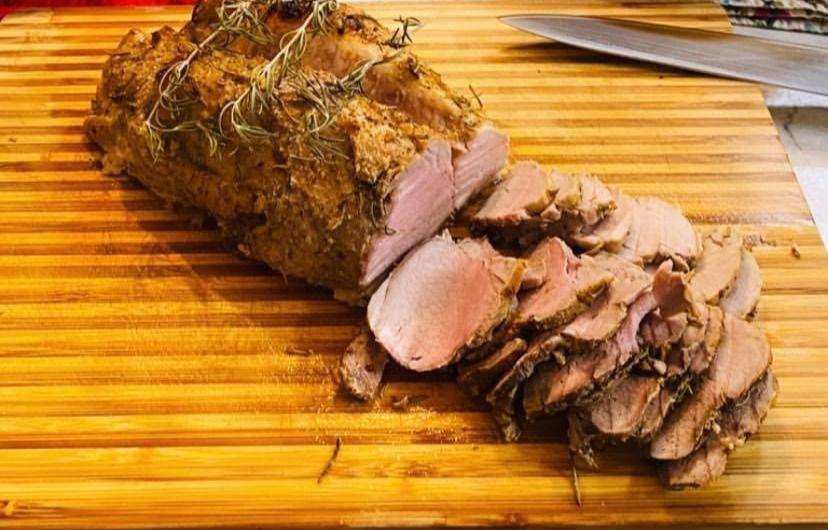Perfect Pork Tenderloin
- Hilary Annette
- Jul 8, 2021
- 4 min read
Updated: Jul 9, 2021

There are two key aspects to getting perfectly cooked, succulent pork tenderloin: the marinade (give it time!) and the meat thermometer. My marinade is very simple, composed of fresh garlic, herbs, and citrus fruits with a little bit of olive oil and spices thrown in for good measure. The secret to making a good marinade great is giving it enough time to really tenderize the meat and allow the flavours to seep through it. I like to let the flavours all meld together for a good 24 hours, but you can even push it to 36 hours if you’re that hardcore.
But before we go any further, yes, you do need a meat thermometer. If you’re anything like I used to be, you are probably thinking “that’s too complicated, I’ll just eyeball it!” – But I beg you to reconsider. Invest in a meat thermometer now (they’re like $12) and never waste another expensive cut of meat by overcooking it again. They are much easier to use than most people think, I promise! The needle simply goes into the thickest part of the cut of meat, and from there you wait for it to reach the desired internal temperature. For this recipe we will be aiming for an internal temperature of 145-150 degrees Fahrenheit (about medium doneness) , but you can always Google search the internal temperature for your personal desired doneness either for this recipe or for any future meat cooking that you might be doing.
If you’re still with me, congrats! You’re serious about your meat, and you can be my friend. You will need to decide how you want to sear your tenderloin – you can do this either on the grill or on the stovetop. The grill is my method of choice, but in the cold winter months you can’t catch me outside so I’ve done stovetop more often than not. The results are equally delicious; just lacking the gorgeous grill marks.
Serves: 6
Prep time: 10 mins
Marinade time: 24 hrs
Cook time: 20-35 mins (depending on size – the rule of thumb is about 25 mins per pound)
What you need:
meat thermometer
1 freezer bag (or you can marinade the meat in a large bowl as long as it’s covered, but a freezer bag works better to lock the flavour in)
2 pork tenderloins, ¾ -1 lb each (usually when you buy pork tenderloin at the grocery store, the package will contain two)
Note: This is my basic (and favourite) marinade, but you can mix it up based on personal preference! Want to go for a spicy Southwest flavour? Try cilantro instead of the other herbs and add some chili powder to the marinade, have fun with it.
For marinade:
1 cup fresh herbs, coarsely chopped (rosemary, mint, basil, and oregano are my favourites to use here)
2 cloves garlic, pressed
1 large lemon or two limes
1/3 cup olive oil
2 tsp garlic powder
2 tsp dried oregano
salt & pepper to taste
What you do:
Place both tenderloins in a freezer bag and add all of the marinade ingredients, squeezing the lemon or lime juice directly into the bag and then tossing the entire fruit into the bag as well for extra flavour. Be generous with the salt. With your hands, rub the marinade all over both tenderloins, making sure that all of the ingredients get mixed together in the process. Once both tenderloins are covered in the well-mixed marinade, tightly squeeze the freezer bag shut, making sure that there is no extra air in the bag.
Refrigerate for 24-36 hours before cooking, flipping the bag over approximately halfway through the marinating time to ensure even coverage. Tip: place a large plate under the bag in the fridge to avoid any leakage.
Once the marinating time is up, preheat oven to 325 degrees.
Sear both tenderloins on medium high heat using either a grill or a non-stick frying pan on the stove. This is just to get a bit of colour on each side of the tenderloins and should take no more than a few minutes.
Place both tenderloins on a baking sheet (you may want to line it with parchment paper or tinfoil) and then stick the needle of the meat thermometer into the middle of what appears to be the thickest part of the largest tenderloin. Tip: you will know that you hit the middle when the temperature drops to the lowest number. Poke around a little bit if you need to. Hint: the reason that we only need one meat thermometer for two tenderloins is because as long as we know that the thickest part of the largest tenderloin is cooked to medium rare, the rest of the tenderloin will range from medium to medium well.
Roast the tenderloins until the meat thermometer reads 145 degrees, about 25 mins per pound. If you prefer your meat a bit more well-done, take it out when the thermometer reads 150 degrees as this will allow the thickest part of the meat to be cooked to medium doneness while the rest of the meat ranges from medium to medium-well. Note: the pork will continue to cook slightly while it cools down and the juices are absorbed.
Allow the tenderloins to sit for at least 10 mins before cutting them against the grain and serving. The longer the meat is allowed to sit, the juicier it will be once it gets cut. Tip: top with more fresh herbs and drizzle with some more citrus juice, and then sprinkle with salt and pepper before serving. Enjoy!





Comments